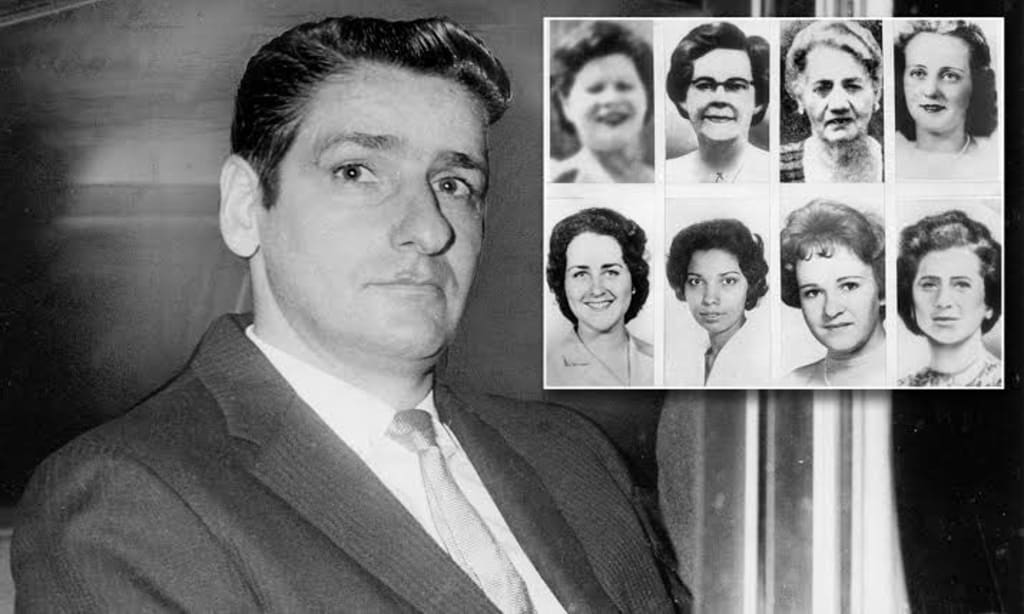Serial Killings: Boston's Terror Unveiled
Albert DeSalvo, the "Boston Strangler," terrorized Boston with a series of brutal murders from 1962 to 1964.

Albert DeSalvo, infamously known as the Boston Strangler was a serial killer who terrorized the city of Boston during the early 1960s. His heinous crimes and the subsequent investigation captivated the nation and left an indelible mark on the history of criminal profiling and law enforcement techniques.Born on September 3, 1931, in Chelsea, Massachusetts, DeSalvo exhibited troubling behavior from a young age. He faced a tumultuous upbringing marked by a dysfunctional family and numerous run-ins with the law. DeSalvo's criminal record included charges of robbery, sexual assault, and breaking and entering. However, his most sinister acts began in 1962 when a series of brutal murders gripped Boston.Between 1962 and 1964 a total of thirteen women were strangled to death in the Boston area each with evidence of sexual assault and binding. The chilling nature of the crimes and the seemingly random choice of victims created a sense of panic and fear within the community. The Boston Strangler's modus operandi varied, making it difficult for law enforcement to connect the dots between the murders.
In 1965, DeSalvo was arrested for an unrelated sexual assault charge and was subsequently identified as a suspect in the Boston Strangler case. While in custody he confessed to the thirteen murders providing disturbingly accurate details about the crimes. However, his confessions were inconsistent, and some details contradicted the evidence at the crime scenes. This led to skepticism about the validity of his claims.DeSalvo was not charged with the murders themselves but was convicted of his other criminal activities. He was sentenced to life in prison. Meanwhile, the debate over his involvement in the Boston Strangler case continued. Some believed his confessions were genuine, while others suspected he may have fabricated them to gain notoriety or avoid the death penalty.The case took another turn when author Gerold Frank published a book titled The Boston Strangler in 1966, which portrayed DeSalvo as the sole perpetrator of the crimes. This book played a role in shaping the public's perception of the case and solidifying DeSalvo's image as the Boston Strangler.
In the decades that followed, forensic techniques and advancements in criminal psychology shed new light on the case. Some researchers began to doubt DeSalvo's involvement suggesting that there might have been multiple perpetrators responsible for the Boston Strangler murders. DNA evidence also became a significant factor, and in 2001 DeSalvo's body was exhumed for testing. However, the results were inconclusive due to the degraded state of the DNA samples. The case's mysteries and unanswered questions have persisted to this day. Despite DeSalvo's confessions and his portrayal as the Boston Strangler, doubts about his sole responsibility for the murders persist. Some investigators and experts continue to explore alternate theories, including the possibility of an accomplice or copycat killers. Albert DeSalvo's story remains a chilling chapter in the annals of criminal history. His crimes shocked a city and left an enduring impact on law enforcement practices and criminal profiling. The legacy of the Boston Strangler case serves as a reminder of the complexity and challenges that surround the pursuit of justice in cases of serial killers and the importance of thorough and evidence-based investigations.
About the Creator
Enjoyed the story? Support the Creator.
Subscribe for free to receive all their stories in your feed. You could also pledge your support or give them a one-off tip, letting them know you appreciate their work.





Comments
There are no comments for this story
Be the first to respond and start the conversation.